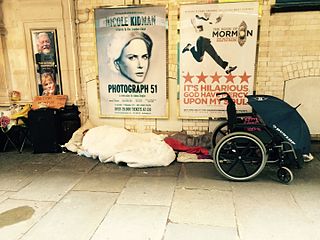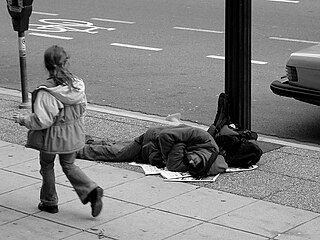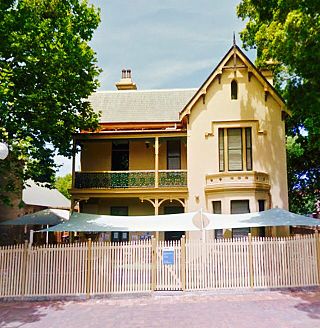Related Research Articles

In the United States, the number of homeless people varies from different federal government accounts. In 2014, approximately 1.5 million sheltered homeless people were counted. In 2018, the Department of Housing and Urban Development estimated roughly 553,000 homeless people in the United States on a given night, or 0.17 percent of the population. Approximately 65 percent of people were sheltered in provided housing while 35 percent were unsheltered. Annual federal HUD reports contradict private state and local reports where homelessness is shown to have increased each year since 2014 across several major American cities, with 40 percent increases noted in 2017 and in 2019.
Supportive housing is a combination of housing and services intended as a cost-effective way to help people live more stable, productive lives, and is an active "community services and funding" stream across the United States. It was developed by different professional academics and US governmental departments that supported housing. Supportive housing is widely believed to work well for those who face the most complex challenges—individuals and families confronted with homelessness and who also have very low incomes and/or serious, persistent issues that may include substance use disorders, mental health, HIV/AIDS, chronic illness, diverse disabilities or other serious challenges to stable housing.

Homelessness in Australia is a social issue concerning the number of people in Australia that are considered to be homeless. There are no internationally agreed upon definitions of homelessness, making it difficult to compare levels of homelessness across countries. A majority of people experiencing homelessness long-term in Australia are found in the large cities of Sydney, Melbourne, Brisbane and Perth. It is estimated that on any given night approximately 116,000 people will be homeless and many more are living in insecure housing, "one step away from being homeless". A person who does not obtain any shelter is often described as sleeping 'rough'.

In England, local authorities have duties to homeless people under Part VII of the Housing Act 1996 as amended by the Homelessness Act 2002. There are five hurdles which a homeless person must overcome in order to qualify as statutory homeless. If an applicant only meets the first three of these tests Councils still have a duty to provide interim accommodation. However an applicant must satisfy all five for a Council to have to give an applicant "reasonable preference" on the social housing register. Even if a person passes these five tests councils have the ability to use the private rented sector to end their duty to a homeless person.
Housing First is a policy that offers unconditional, permanent housing as quickly as possible to homeless people, and other supportive services afterward. It was first discussed in the 1990s, and in the following decades became government policy in certain locations within the Western world. There is a substantial base of evidence showing that Housing First is both an effective solution to homelessness and a form of cost savings, as it also reduces the use of public services like hospitals, jails, and emergency shelters. Cities like Helsinki and Vienna in Europe have seen dramatic reductions in homelessness due to the adaptation of Housing First policies, as have the North American cities Columbus, Ohio, Salt Lake City, Utah, and Medicine Hat, Alberta.

The Minister for Social Services is the Australian federal government minister who oversees Australian Government social services, including mental health, families and children's policy, and support for carers and people with disabilities, and seniors. Amanda Rishworth was appointed as minister on 1 June 2022, following the Australian federal election in 2022.
Najidah is a nonprofit secular organisation in Australia dedicated to reducing societal tolerance of abuse and the development of safer communities. Located in Queensland on the Sunshine Coast, it was founded as "Jacana lodge" in the early 1990s before becoming an incorporated association in 1999.

Homelessness in the United Kingdom is measured and responded to in differing ways in England, Scotland, Wales and Northern Ireland but affects people living in every part of the UK's constituent countries.

Homelessness or houselessness – also known as a state of being unhoused or unsheltered – is the condition of lacking stable, safe, and functional housing. People can be categorized as homeless if they are:

Anti-homelessness legislation can take two forms: legislation that aims to help and re-house homeless people; and legislation that is intended to send homeless people to homeless shelters compulsorily, or to criminalize homelessness and begging.
Crisis accommodation is housing provided to people experiencing temporary or ongoing conditions of mental or physical health challenges. It aims to remove them from an otherwise harmful environment and allowing them to improve their situations from a safe and stable environment. Situations that may be alleviated through crisis accommodation include but are not limited to homelessness, domestic violence, elder abuse, and child abuse. Crisis accommodation is typically provided through government organisations, not-for-profit organisations and charities. Crisis accommodation is also known as housing subsidies in other words. Crisis accommodation is provided everywhere around the world across various countries. There are other factors such as availability of the services and reasons like poverty and accumulation of debt that affect homelessness which needs to be taken into account in order to solve it as more people tend to look for urgent support when they are facing this crisis.
Youth Off The Streets is an Australian non-denominational not-for-profit youth organisation. The organisation works with young people and their families and communities in an endeavour to create safety, offer support and provide opportunities to build a positive future.
Launch Housing is a secular Melbourne-based community organisation that delivers homelessness services and housing supports to disadvantaged Victorians.
Sacred Heart Mission in St Kilda, an inner suburb of Melbourne, is a medium-sized not-for-profit organisation that grew from the Catholic parish of The Sacred Heart in Grey Street, West St Kilda. It addresses homelessness, social exclusion and disadvantage by providing a range of diverse and creative services that:

Caretakers Cottage is an Australian non-profit, non-governmental organisation based in Sydney assisting children and young adults facing homelessness. Caretakers Cottage is funded by the New South Wales Department of Family and Community Services to provide services for young people across Sydney's South-Eastern district. Services include short-term, emergency accommodation, semi-independent living options, case support and early intervention for young people at risk of homelessness.
Family Promise is a national 501(c)(3) nonprofit organization in the United States, founded by Karen Olson in 1988. Family Promise primarily serves families with children who are homeless or at risk of homelessness, with the mission of "help[ing] homeless and low-income families achieve sustainable independence through a community-based response."

Family homelessness refers to a family unit who do not have access to long term accommodation due to various circumstances such as socioeconomic status, access to resources and relationship breakdowns. In some Western countries, such as the United States, family homelessness is a new form of poverty, and a fast growing group of the homelessness population. Some American researchers argue that family homelessness is the inevitable result of imbalanced “low-income housing ratio” where there are more low-income households than there are low-cost housing units. A study in 2018 projected a total of 56,342 family households were recognized as homeless. Roughly 16,390 of these people were living in a place not meant for human habitation. It is believed that homeless families make up about a third of the United States’ population, with generally women being the lead of the household.
The Foyer housing model is a method of transitional housing for youth that evolved from temporary housing for laborers in Europe. After World War II, foyers were used to provide accommodation for a movement of people from rural France to cities seeking work. The term "foyer" means hearth in French. They later developed to house migrant workers, primarily from Algeria, serving as a path to independent labor and accommodation.
The NSW Women's Refuge Movement began in 1974 with the establishment of Elsie Refuge in Glebe, NSW. Other refuges were established throughout the 1970s, operating within a feminist framework and responding to the needs of women and children escaping domestic violence. At first, the refuges were developed through volunteer effort and without government funding. Gradually the government took over funding of the refuges, with the states funding the buildings and the federal government funding the running costs. The NSW Women's Refuge Movement continued to provide services to women with diverse needs and to raise awareness about domestic violence.
Jenny's Place was established in 1977 and was the first women's refuge in New South Wales' Newcastle region. The establishment of Jenny's Place was integral in the response to the recognised need for feminist housing and crisis services for women and children escaping domestic and family violence, part of the original New South Wales Refuge Movement. It was one of the earliest refuges to open following that of Elsie Refuge, Bonnie Women's Refuge and Marrickville Women's Refuge. Today, the refuge continues to operate as Jenny's Place Inc., and is a registered public benevolent charity.
References
- 1 2 Supported Accommodation Assistance Act 1994
- ↑ Western Australia SAAP information
- ↑ ABS definition of homelessness
- ↑ "Supported Accommodation Assistance Program (SAAP) (AIHW)". Archived from the original on 2016-09-19. Retrieved 2016-09-13.